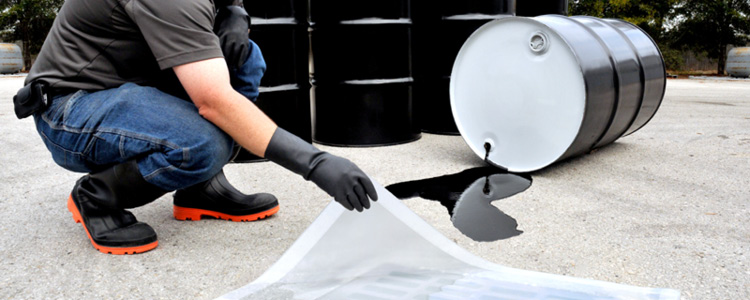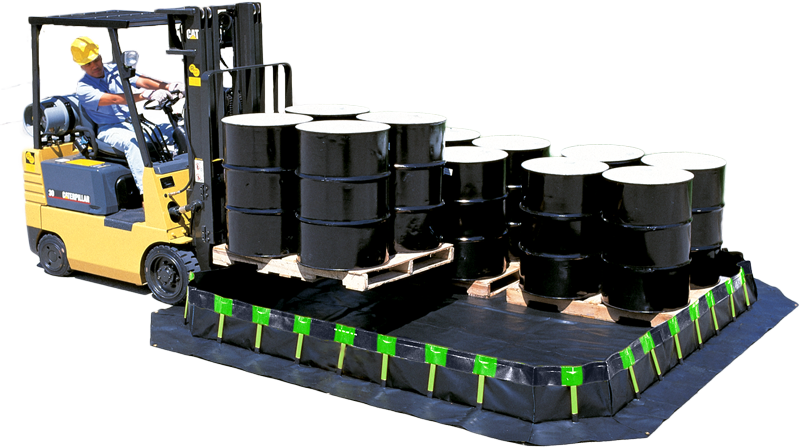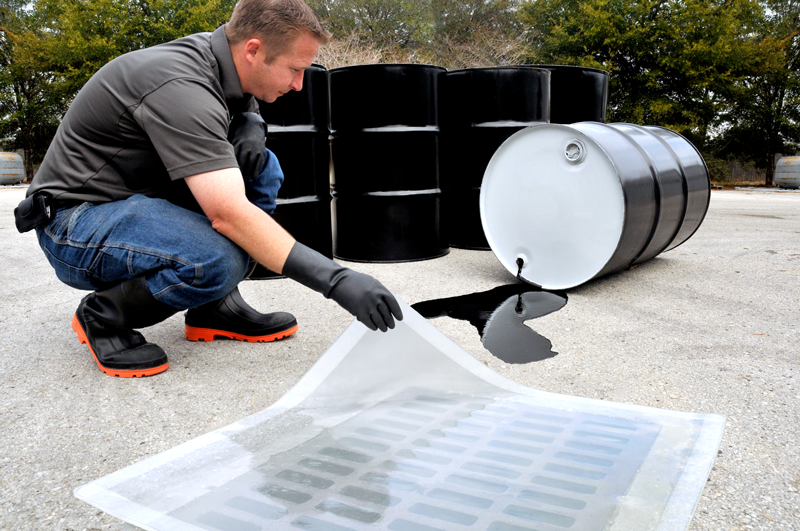Model:
Your Model No.:
Mfr. Model No.:

This regulation does not specify how much containment is required. A person who stores hazardous waste shall store it in an amount and manner so that:
The owner of a storage facility where free liquid hazardous waste is stored in containers or tanks must:
Containment dikes and other protection:
Where, in the opinion of the director or an environmental officer, an aboveground storage tank system is situated in a location such that a release of petroleum product or an allied petroleum product could create a risk to surface water or groundwater quality, or to public health or safety, the director or environment officer may order the owner of the system to:
There is no specific government document available. The requirements for spill prevention and containment for chemicals/hazardous waste storage are issued under a Certificate of Approval by the Department of Environment and Conservation.
Areas in which chemicals are used or stored shall have impermeable floors and dikes or curbs and shall not have a floor drain system, nor shall they discharge to the environment. Areas inside the dikes or curbs shall have an effective secondary containment capacity of at least 110% of the chemical storage tank capacity, in the case of a single storage container. If there is more than one storage container, the diked area shall be able to retain no less than 110% of the capacity of the largest container or 100% of the capacity of the largest container plus 10% of the aggregate capacity of all additional containers, whichever is greater. These diked areas shall be kept clear of material that may compromise the capacity of the dike system. Once a year, the dikes shall be visually inspected for their liquid containing integrity, and repairs shall be made when required. Once every ten years, the dikes shall be inspected by a means other than visual inspection for their liquid containing integrity and repairs shall be made when required.
Refueling and maintenance of vehicles and equipment shall, whenever possible, be undertaken on a prepared impermeable surface with an oil containment or collection system.
There is no specific government document available. The requirements for spill prevention and containment for chemicals/hazardous waste storage are issued under a Certificate of Approval by the Department of Environment and Conservation.
Areas in which chemicals are used or stored shall have impermeable floors and dikes or curbs and shall not have a floor drain system, nor shall they discharge to the environment. Areas inside the dikes or curbs shall have an effective secondary containment capacity of at least 110% of the chemical storage tank capacity, in the case of a single storage container. If there is more than one storage container, the diked area shall be able to retain no less than 110% of the capacity of the largest container or 100% of the capacity of the largest container plus 10% of the aggregate capacity of all additional containers, whichever is greater. These diked areas shall be kept clear of material that may compromise the capacity of the dike system. Ince a year, the dikes shall be visually inspected for their liquid containing integrity, and repairs shall be made when required. Once every ten years, the dikes shall be inspected by a means other than visual inspection for their liquid containing integrity and repairs shall be made when required.
Refueling and maintenance of vehicles and equipment shall, whenever possible, be undertaken on a prepared impermeable surface with an oil containment or collection system.
All containers or tanks shall be completely surrounded by secondary containment sized to contain 110% of the volume of the largest tank or container in the specifically contained area or 100% of the volume of the largest tank or container plus 10% of the aggregate capacity of all other containers or tanks in the contained area, whichever is greater.
All transfers of bulk dangerous goods shall be conducted using containment pads or drip pans to capture spills or drips during transfer operations to/from railcars and other approved containers.
Secondary containment – general: Containment systems should be installed around all liquid chemical or waste storage containers to collect and contain a leak, spill or overfill from the tank, connections, vents or pressure relief devices. Containment systems should be designed such that the horizontal trajectory of a potential leak from a tank will be confined within the impoundment. As a guide, the perpendicular distance from the tank face to the top of the inside face of any containment should be a minimum of half the height of the tank above the top of the containment wall. The secondary containment system should isolate and protect the tank from vehicular traffic, fire, and spills of incompatible materials that might occur in adjacent storage or work areas. Containment areas may be emptied manually, by pumps or by ejectors. However, all should be manually activated and the condition of the accumulation should be examined before starting to be sure no contaminants will be discharged into the environment. Accumulations from a secondary containment system should be treated or decontaminated in accordance with local requirement for discharges to sanitary sewer or in accordance with the site certificate of approval and sector specific Effluent Monitoring. Containments should be sized so as to provide a minimum impoundment volume equal to the greater of 110% of the volume of the largest tank, 100% of the volume of the largest tank plus the greater of 10% of the volume of the largest tank or 10% of the aggregate volume of all remaining tanks.
Construction Requirements: All containment areas should be structurally sound, impermeable and able to withstand chemical deterioration and structural stresses from internal and external causes. Containments in flood plains should be designed and constructed to withstand structural damage and overtopping by 1 in 100 year run-off or a storm event. The secondary containment system should be designed and constructed, coated or lined with a permeability rate to the material stored of 1 X 10¯⁶ cm/sec or less and be chemically compatible with the contents of all tanks within the containment area. Tank containment systems should not be located over any existing piping or drainage system whether active or inactive. The floor of the containment should have a minimum slope of 1.5% towards a sump to ensure that any runoff or spilled material will be contained. There should be no sewer connections from any containment area, other than through the containment valve. There should be no piping through the basin floor. If a synthetic liner is used as a secondary containment system, synthetic liners should be at least 60mm in thickness and should be made of a material that will not deteriorate in an underground environment. All punctures, tears or inadequate seams in the liner should be repaired prior to backfilling. The liner should be installed with a slope to the sump of at least 1.5%. All containments should be equipped with a sump with a minimum capacity of 1.5 m³ from which runoff or spilled material may be pumped or drained by means of a containment valve. Containment valves should be locking position indicator valves. They should be normally locked in the closed position with access restricted.
Underground Installations: When using a double-walled tank for a secondary containment system, the tank should be designed such that the outer wall can contain a release from the inner wall and it should enclose the entire primary tank. The interstitial space should be regularly monitored. The outer wall should be protected against corrosion similar to the inner tank to prevent rupture. The outer wall should be designed to handle the maximum pressure of the inner wall. If a vault is used as a secondary containment system, the vault should be a continuous structure with a chemical resistant water stop used at all joints. For underground installations, appropriate signs should be put in place to indicate the location of the underground facility. Also, an underground barrier should be put in place to prevent possible rupture during excavations that could otherwise encroach upon the underground system.
Piping and Pumps: Pipes draining containment systems should be capable of handling the maximum potential water spray cooling and fire protection system flow within the containment. All piping and containment valves should be protected from freezing. Any coupling or open-ended valve used for making a transfer should be located within a secondary containment system of the transfer station.
Transfer, Loading and Off-Loading: The ground around the loading/unloading system area should be sloped a minimum of 1.5% toward a containment system
No person shall install an aboveground single-wall storage tank with a capacity of 2300 liters or greater without a secondary containment system.
The volumetric capacity of the containment system required shall be: a) in the case of one storage tank, 110% of the petroleum storage capacity of the storage tank or b) in the case of a multi-tank storage tank system, 110% of the petroleum storage capacity of the largest storage tank.
The containment capacity of the containment system required shall be calculated after deducting the exterior displacement volume of the storage tanks, with the exception of the largest tank, in order to allow for the displacement volume occupied by the storage tanks.
No person shall install an aboveground storage tank or storage tank system in a manner that may result in such a storage tank, or storage tank system being in contact with the ground, unless an adequate corrosion control system is installed at the same time to protect the portion of any storage tank that may be in contact with the ground and such storage tank or storage tank system complies with the NFC of Canada.
Every building used to store residual hazardous materials shall be built in such a way as to protect what is stored from any alteration caused by water, snow, frost or heat. The floor shall be impermeable, not liable to be attacked by the stored material and able to support that material. In addition, the layout of the storage area shall be such that leakage or spillage can be contained.
Every shelter under which residual hazardous materials are stored shall have at least 3 sides, a roof and a floor. The floor shall be impermeable, not liable to be attacked by the stored material and able to support that material. The floor shall rise on each side to form an impermeable basin able to hold the greater of the following volumes: 25% of the total capacity of all the receptacles stored therein and 125% of the capacity of the largest receptacle.
As of April 1, 1995, all waste dangerous goods storage facilities with 500 kilograms/500 liters of waste oil or antifreeze at one time or 100 kilograms/100 liters of all other waste dangerous goods combined, must comply with the Regulation.
Waste dangerous goods container storage areas must be equipped with some form of secondary containment to prevent waste dangerous goods from entering any storm, sanitary sewage or water supply system or from contaminating any other area. The secondary containment must be impermeable (leak tight) and constructed of a material compatible with the waste being stored.
Tanks should be equipped with secondary containment. Acceptable containment systems include: double wall tanks, containment dikes constructed from steel, concrete, earthen dike and liner systems, or other systems which meet the following minimum requirements:
The CCME "Environmental Code of Practice for Aboveground Storage Tank Systems Containing Petroleum Products"
Used oil storage tanks that are manually filled

Used oil storage tanks that are manually filled

Shall conform to NFC, Subsection 4.3.7 in addition to the following performance specifications:

Max quantity is 999999999. Your cart item has been updated
Model:
Your Model No.:
Mfr. Model No.:
Qty.: